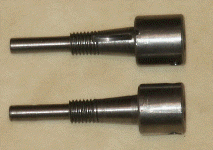December 2002
Tuesday 17th December 2002
|
I collected the two sprocket motor shafts from Bill at my friendly engineering company Settform. They locked onto the motor shaft by a couple of grub screws while the other end would be supported in a bearing. There was sufficient motor shaft protruding from either side for me to mount the sprocket shaft on which ever side I wanted. This would be useful because the motors ran at slightly different speeds forwards to backwards, so if I used one side for motor end for the left drive and the opposite side for the right motor, they I stood a chance that the robot would run straight. |
 |
Sunday 21st December 2002
I spent most of today putting right the small faux-pas I made yesterday. I wanted to try out the two motors on my newly designed 24 volt motor controller now that I had both motors back from the engineering work where I had the sprocket shafts made. I didn't want to risk blowing up the power MOSFETs, so used a small wire on the negative power feed to the MOSFETs that I hoped would act as a fuse should something go wrong. If the wire burnt out, then this would cut the negative supply to the MOSFETs.
I connected one motor to the controller and wound the wick up a bit. All seemed good, even though I could see the small wire getting a bit hot and saging. I decided to go for broke and run the motor at full speed for a while. The small wire glowed red for a second and then blew and the motor started to slow down.
What happened next was a bit of a surprise because eight resistors on the MOSFET driver part of the circuit spontaniously combusted and sent small flames leaping into the air. It took me the best part of Sunday to establish exactly how many components had gone up in sympathy with these resistor, and the final toll was :
- Six power MOSFETs
- Five driver stage transisors
- Eight driver stage resistors
The reason for this avanlanche of sympathetic failure was (I think) that when the negative supply rail burnt out, the driver stage was still providing signals to the MOSFET gates. These signals were now well below the only reference voltage left on the MOSFETS, which according to the data sheet is liable to blow the gate junctions. With the MOSFETs effectively shorted out, they fed the full 24 volts back into the driver circuits burning out some resistors and transistor en-route before everything else ended in a chared mess.
Looking on the bright side, I now know how to dismantle the MOSFET bricks and change the transistors should I need to again in the future.